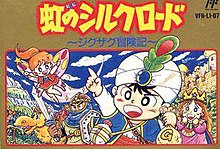Niji no Silkroad
 Cover art | |
| Developer(s) | Advance Communication Company |
|---|---|
| Publisher(s) | Victor Musical Industries |
| Designer(s) | Kazuo Enomoto[1] |
| Composer(s) | Asei Kobayashi Ryoko Kihara (Arranger) Shigeo Kihara (Director) Osamu Kasai (Sound Programming) Masaaki Harada (Sound Programming) Michiharu Hasuya (Sound Programming) |
| Platform(s) | Family Computer |
| Release |
|
| Genre(s) | Role-playing video game |
| Mode(s) | Single-player |
Niji no Silk Road (虹のシルクロード, "Rainbow Silk Road") is a role-playing video game for the Famicom. It was developed by Advance Communication Company and published by Victor Musical Industries in 1991. The game was only released in Japan.[2][3]
Gameplay[edit]

The game differs from other games in the genre by placing high importance on the player's ability to buy and sell items to make money. Niji no Silk Road features turn-based, first-person combat, but enemies do not drop money or experience points. License points are earned after battles that grants the prince the ability to sell more goods in different places. The player moves the prince through towns and on the world map across the Silk Road, where enemies can attack. The world map features different types of terrain, including deserts that deplete the prince's water supply, which will kill him if fully depleted.
Goods, such as clayware, can be purchased in a town and then sold in a town where the good is more valued. The player can purchase animals to increase the number of goods they can carry and they can hire soldiers to aid the prince in battle.
Plot[edit]
The player controls the main protagonist, an exiled prince of LittleLand that has been recently informed of his royal heritage. To reclaim the throne, the prince must collect seven shards of the Rainbow Mirror and defeat the usurper, Zrool. The shards are scattered throughout Asia and the prince must trade goods to make his way to each region. Once the mirror is collected, the prince shines it at Zrool and exposes the imposter. The prince then takes his throne as the new king.[4]
Music[edit]
The game's music was composed by famed Japanese composer Asei Kobayashi. The music mostly consists of middle-eastern themes (using the Hungarian minor scale). The music was arranged for the Famicom by Ryoko Kihara, and was directed by Shigeo Kihara of Astro Music. The two had previously worked on the Famicom title Momotarou Densetsu. While the sound was outsourced, the sound driver and effects were done by the developer, Advance Communication Company.
A soundtrack CD for the game was released titled "Rainbow Silk Road Image Album WINDY ROAD." It contains the in-game music, with the addition of a few arrangements.[5]
References[edit]
- ^ VGMPF - Niji no Silkroad Credits
- ^ GameFAQs staff. "Rainbow Silkroad". GameFAQs. Retrieved 2010-02-25.
- ^ GameSpot staff. "Rainbow Silkroad for NES". GameSpot. Retrieved 2010-02-25.
- ^ "The Prince shined it on Zrool before all the people. Foiled, Zrool fled, never to be seen again. The prince ascended the throne and became the new King." NHK (2010-02-25). Niji no Silkroad (Famicom). Victor.
- ^ "「虹のシルクロード」イメージアルバム WINDY ROAD - 電子遊戯音盤堂 Wiki".
